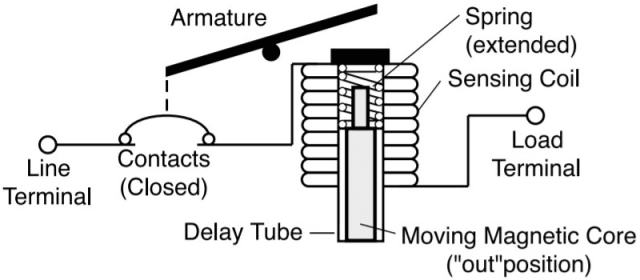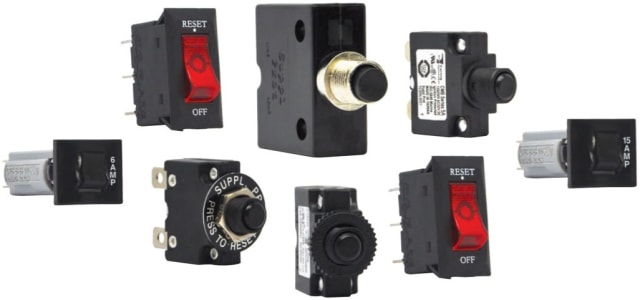The Fight Against Critical Failures Starts with Circuit Protection

Circuit protection doesn’t need to be complicated, but different use-cases and environments necessitate smarter designs and engineering to ensure today’s delicate electronics, computers and machinery don’t get fried during overcurrent events. (Image courtesy of Carling.)
The electronics in our devices, machinery and infrastructures have become smaller, more complicated and more delicate. While this trend toward miniaturization has allowed us to fit stronger, smarter and faster devices into nearly everything, it has also made our devices more sensitive to unpredictable surges in power and other overcurrent events.
It isn’t just consumer electronics or household circuitry that needs protection. Since the electrification of the United States of America in the 19th Century, the electrification and ensuing automation in our factories and assembly lines—and in the last few decades, massive data centers. All told, these demands for electrical power have exceeded what anyone in the 1800s would have predicted. This unprecedented growth in power use—from our household PCs to the PLCs in our factories—necessitates reliable protection against overcurrent events to ensure the lifestyles of our citizens as well as the productivity of our economies.
Among the many vulnerabilities of modern electronics, two main overcurrent events are the most common. One of the most common overcurrent events is short circuiting. Short circuiting occurs when there is a loop from the power source back to itself where little-to-no impedance acts on the current. This turns the circuit into a positive feedback loop with the electrons in the circuitry resonating, becoming more energized over time. The only sink for this increasing energy is to transform that energy into thermal energy. This increase in heat can damage sensitive electronics and circuitry, even leading to explosions.
The second most common overcurrent events are power surges. These happen when abnormal increases in current are added to a circuit that exceeds the expected current-load for which the circuit has been engineered. One example of this is a lightning strike near an electric power infrastructure.
Furthermore, protecting against overcurrent events isn’t only an effort to protect electronics or industrial machinery; it is also to protect workers and users. That is, circuit protection also acts as a safety measure to ensure the livelihood of people such as factory workers, consumers—and those nearby. Overcurrent events can cause explosions, fires and exceed amperage levels beyond what the human body can withstand. In the event of an energized overcurrent, circuit protection is the last line of defense against life-threatening injuries or accidents.
How Circuit Protection Works
Circuit protection is built around the notion of engineering a weak point along a circuit so that overcurrent events that breach a threshold current will trigger a breaker or switch to open the circuit and halt the current.
Fuses were among the first widely accepted methods of circuit protection. Usually, fuses are thin pieces or strips of metal with a melting point that is near the temperatures its resistance would produce with an unacceptable amount of current. Thermal energy from the current causes the metallic fuse to melt and open the circuit, halting all current. While fuses serve their purpose well, their relatively simplistic design can vary in effectiveness depending on the specific use-case. Sometimes, it is necessary to use more complicated circuit protection methods that provide advantages in more complicated use-cases.
Enter circuit breakers.
Circuit breakers were designed as a more reliable source of protecting circuitry and electronics. A circuit breaker contains multiple parts that can be calibrated by users or manufacturers to meet the needs of individual use-cases—rather than relying on the resistivity of a thin strip of metal, as a fuse does. The design of circuit breakers can vary by uses and conditions, but the general idea is that one component is affected by current (thereby monitoring the current), while another component (sometimes known as an actuator) breaks the circuit upon the event of overcurrent.
Available Modern Hardware
There are three main streams of modern hardware used for the protection of circuits from overcurrent events: hydraulic-magnetic, thermal and leakage (sometimes known as ground fault).
Hydraulic-magnetic circuit breakers are comprised of a hydraulic component and a magnetic component. They utilize electromagnetism theory that governs solenoids and iron-core rods to control the flow of electricity throughout the solenoid as the iron-core rod surrounded by the solenoid moves. The reaction time of these circuit breakers depends on the viscosity of the liquid used that acts as a medium between the iron-core rod and the solenoid. The more viscous the liquid used, the higher the threshold for an overcurrent event.

Thermal circuit breakers utilize bimetallic strips and use a process like that found within thermostats. The two metals of the strip each respond differently to thermal conditions, with one metal expanding more quickly than the other. This causes the strip to bend toward the side of the bimetallic strip that expands slower, and opens the circuit if the current is producing too much heat.

Equipment leakage and ground fault circuit breakers utilize measurements of the electromotive force (EMF). Input and output currents produce EMFs that are equal in magnitude but opposite in sign (positive or negative). During normal flow, the sum of the input and output cancel one another out, and the circuit remains closed. In the event of an overcurrent, one of those EMFs would be larger than the other, resulting in a nonzero net EMF that is detected and triggers the circuit to be opened.

Each type of modern circuit breakers has its advantages and disadvantages, and offers solutions for different use-cases. When choosing a type of circuit protection, it is best to understand the pros and cons of each type to see which would satisfy the conditions of the use-case. For example, thermal circuit breakers aren’t ideal for places with too high or too low ambient temperatures that can cause false triggers to take place (too high a temperature) or cause the breaker to never trigger (too low a temperature).
Electronics and machinery in harsh environments need circuit protection solutions that won’t fail under those conditions. For example, if the conditions are underwater or the air has a high concentration of particulates, then a circuit breaker that has been certified sealed at the panel and toggle would work best.
For unmanned situations where the electronics or machinery are not being observed by users or workers, circuit protection is also very important. In such cases, overcurrent events can go undetected for extended periods of time, which can lead to damage to expensive units and circuitry as well as starting and spreading fires. An example of this situation would be in the growing number of arrays in solar energy installations. It isn’t uncommon for engineers at these arrays to put their faith in hydraulic-magnetic circuit breakers due to the ability to withstand extreme temperatures better than bimetallic circuit breakers. However, due to the often-extreme conditions where solar arrays can be installed, some extra design is needed to prevent overheating from the presence of arcs after a breaking of the circuit.
The first step to smarter circuit protection is to investigate which circuit breaker offers the best solution. For any use-case or environmental condition, there’s likely a circuit breaker out there that will decrease costs, lower the likelihood of critical failure, increase safety and satisfy any regional standards and certification. Additionally, just as our machines and electronics are getting smarter and better each day, the technologies and ingenuity behind circuit protection is growing as well, so keep an eye out for new breakthroughs!
For more on Carling’s circuit protection components, visit e-sonic.com.
Master Electronics has sponsored this post. All opinions are mine. --Mitchell Gracie, Engineering.com

 English
English
 French
French

